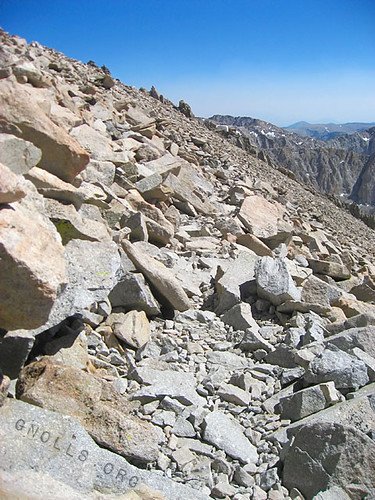“Why Are We Hungry?” will return next week. Meanwhile, I recommend you read it starting from Part I if you haven’t already, because Part III, and particularly Part IV, throw quite a bit of light on currently hot issues.
Adaptation to endurance exercise is important, because our ability to burn fat for energy is important:
J Appl Physiol. 1984 Apr;56(4):831-8.
Adaptations of skeletal muscle to endurance exercise and their metabolic consequences.
Holloszy JO, Coyle EF.The major metabolic consequences of the adaptations of muscle to endurance exercise are a slower utilization of muscle glycogen and blood glucose, a greater reliance on fat oxidation, and less lactate production during exercise of a given intensity. These adaptations play an important role in the large increase in the ability to perform prolonged strenuous exercise that occurs in response to endurance exercise training.
However, one of the biggest problems with endurance training is diminishing returns. Holloszy and Coyle again:
Regularly performed endurance exercise induces major adaptations in skeletal muscle. These include increases in the mitochondrial content and respiratory capacity of the muscle fibers. As a consequence of the increase in mitochondria, exercise of the same intensity results in a disturbance in homeostasis that is smaller in trained than in untrained muscles.
Furthermore, though prolonged endurance exercise results in greatly increased fat oxidation, it also causes a period of decreased mitochondrial efficiency that lasts for at least 28 hours afterward…and probably longer.
Maria Fernström,1,2 Linda Bakkman,1,2 Michail Tonkonogi,2,3 Irina G. Shabalina,2 Zinaida Rozhdestvenskaya,2 C. Mikael Mattsson,1,2 Jonas K. Enqvist,1,2 Björn Ekblom,1,2 and Kent Sahlin1,2
Reduced efficiency, but increased fat oxidation, in mitochondria from human skeletal muscle after 24-h ultraendurance exercise
Journal of Applied Physiology May 2007 vol. 102 no. 5 1844-1849The most important novel findings of the present study were that 1) mitochondrial efficiency decreased after ultraendurance exercise and remained reduced after 28 h recovery; 2) mitochondrial FA oxidation (state 3) and relative FA oxidation [PC/(PC + Pyr)] increased Post-Ex; and 3) noncoupled respiration rate (state 4) was reduced after 28 h of recovery.
Given these facts, we can easily see why “chronic cardio” produces more injuries than it does fitness. Continually pounding out the same mileage, day after day, quickly strands us on a performance plateau of diminishing returns—both in performance and in physique.
Here’s an alarming example, summarized from the above study by one of its authors:
Bakkman, Linda
Mitochondrial function adaptations to changed metabolic conditions
Department of Medicine, Solna, Karolinska Institutet, Stockholm, Sweden, 2010“…The nine subjects were elite ultra-endurance performance athletes, all men. They had an impressive exercise background with 3-9 years of regular extreme endurance exercise and recent merits from national and international championships. … The group had a body fat content of an average 16.9% (range 10.8-26.1) of body weight, which is typical for males of their age.”
So much for the hypothesis that exercise, by itself, is enough to lose fat. If international ultra-endurance champions still carry a “typical” load of 17% bodyfat, how can the rest of us hope to attain the physique we’d like?
Beating The Law Of Diminishing Returns: Occasional Insanity Trumps Daily Misery
As Holloszy and Coyle make clear, the first feat of endurance at a given duration and intensity produces the greatest increase in respiratory capacity. So in order to bring ourselves to a high level of performance, it seems likely that occasional ridiculous efforts would produce the same adaptation as daily lower-intensity effort, for a much smaller time commitment and much less damage to our joints and heart. As I said in "Eat Like A Predator", “The only way to improve is to push your limits.”
To that end, I bring you…
22 Miles, 6200′ Up, 6200′ Down, Zero Calories: Mt. Whitney, Fasted
Inspired partially by Asclepius’ journey, I day-hiked Mt. Whitney—the tallest mountain in the 48 continental United States—on my way home, after the Ancestral Health Symposium. In other words, my training program involved sitting in a chair and listening to presentations…at sea level.
Would-be hikers start at 8,300 feet (2530 meters), and climb almost 6,200 feet (1890 meters) in 11 miles (17.7 km), on their way to the summit at 14,497 feet (4491 meters), before returning down the same trail for a total of 22 miles (35.4 km) and 12,400 feet (3780 meters) of elevation change. (Click here for relief maps, and all the information you could want about attempting it yourself.)
Most people take two or three days, camping at altitude to acclimate…but a substantial number attempt it as a day hike. Since I live at over 6000′ and am in reasonably good shape, I decided that it wasn’t enough of a challenge, and it would be a good test of my metabolic flexibility and ability to oxidize fat if I did the entire hike completely fasted. No breakfast, no energy bars, no sandwiches, no gorp, gels, blocks, shots, powders, or electrolytes. Water and my own fat would have to serve.
Did I mention I also used minimal shoes?
My hike started here, at the Whitney Portal parking lot, where delinquent bears had recently thrown a party.
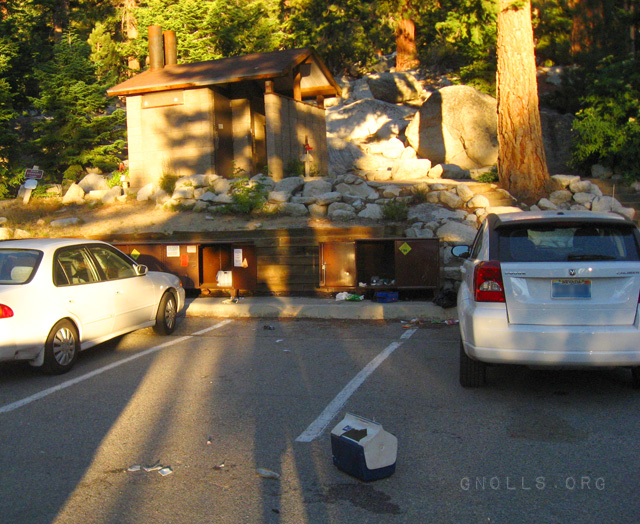
There is an apocryphal quote, usually attributed to a Yosemite park ranger, about designing bear-proof containers: “There is considerable overlap between the intelligence of the smartest bears and the dumbest tourists.”
These food storage boxes were installed so that people don’t leave food in their cars at the trailhead: even a small black bear can easily break into a car, using nothing but its own strength. I suspect what happened here is that some people didn’t properly close the “bear boxes” after stashing their own food. There are two kinds of bear box: one uses a simple hidden latch, but the ones pictured use a sort of Allen key on a chain and are much trickier to open and close.
I found one of the simple ‘hidden latch’ type, and my cooler was safe upon my return.
2000 feet of altitude and several miles later, Whitney Portal is barely visible, with the Owens Valley beyond.
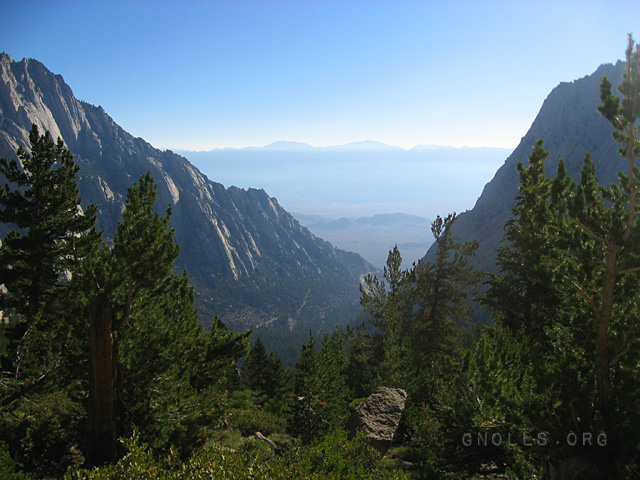
A record snow year meant the creeks were still running. Balance was required.
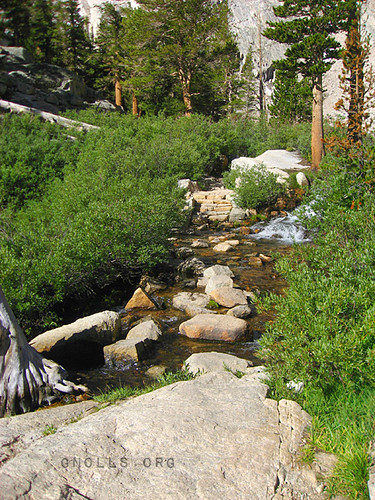

This is the last tree you’ll see. Note the saddle in the far distance: that’s where the previous picture of the Owens Valley was taken from, just a couple hours ago.
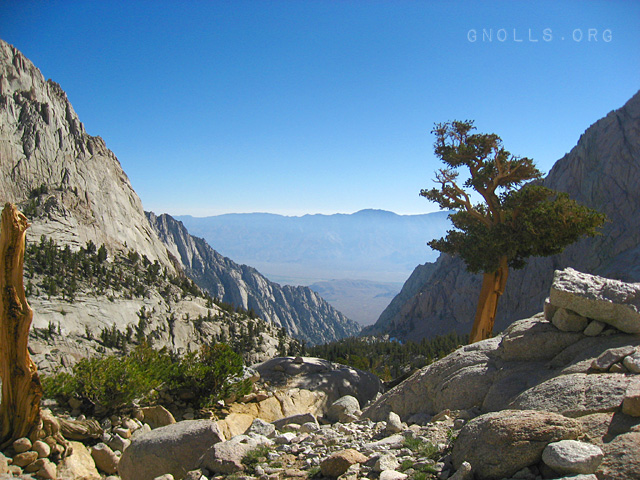
Now we’re in the high alpine. Progress slows somewhat at 13,600′ altitude, and I admit to having felt somewhat lightheaded. I’m not sure whether it was a lack of air or lack of calories, but a short rest at Trail Crest solved my problems.
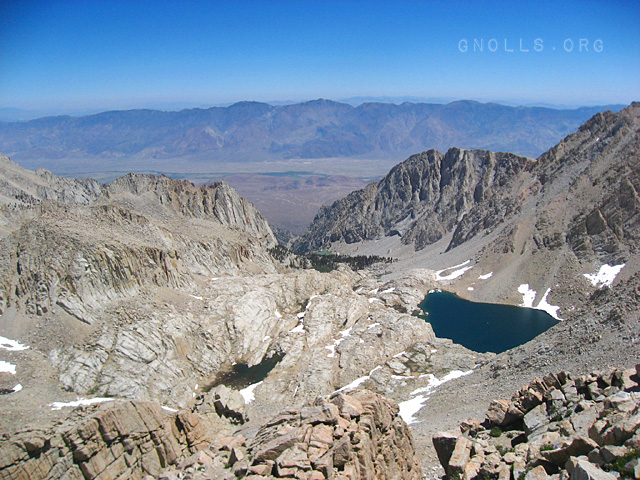
Looking the other direction from Trail Crest:
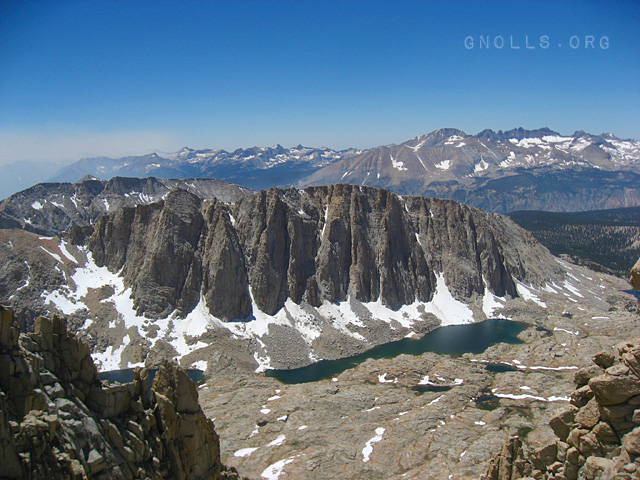 (The haze in the valley is due to a large wildfire to the south.)
(The haze in the valley is due to a large wildfire to the south.)
This hike isn’t like running 22 miles on flat pavement: there are many miles of trail that look much like this:
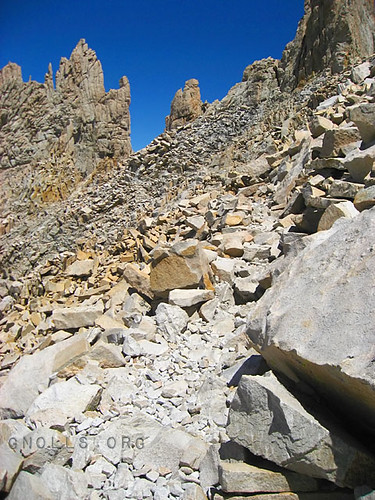
But persistence and a steady pace soon placed me at the summit. Note the cheap skate shoes—which were actually quite functional, having both great ground feel and robust toe protection:

Whereupon I enjoyed stunning views of the entire Eastern Sierra that photographs simply cannot convey, and a relaxed hour or so on top of the world.
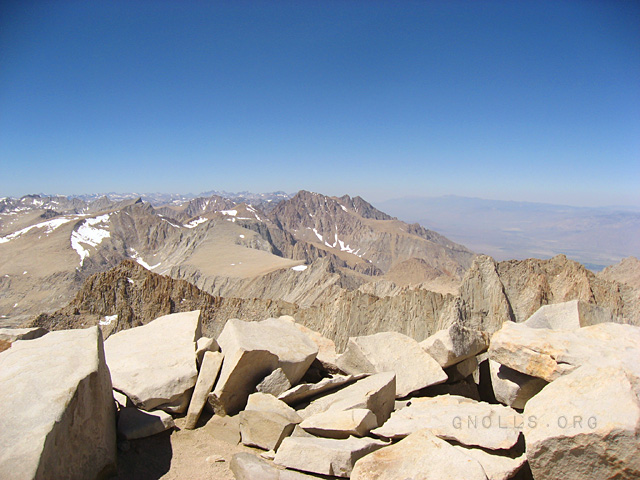
Life establishes itself anywhere it can, even at 14,000 feet:

And on sheer granite walls, where every shelf and crevice supports a tree:
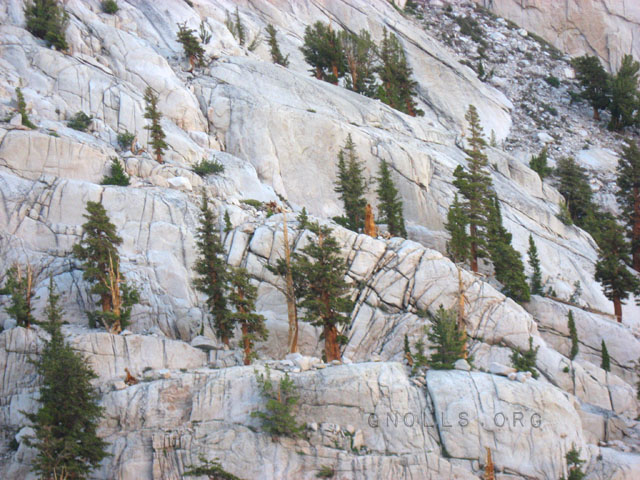
The pictures end here, but the hike continued. I must admit that the final few miles, descending from Outpost Camp, were a grind…I wasn’t desperate or in pain, but I was quite ready to be back at my car, sitting down and eating the delicious gravlax, Greek yogurt, and blueberries I had stashed in a cooler.
Some notes on the journey and recovery, in no particular order:
- I didn’t feel hungry at all during the entire six-hour descent from the peak—and my hunger was totally manageable on the way up. Eating a diet high in saturated fats, primarily from meat and coconuts, appears to have increased my ability to oxidize my own fat for energy.
- I had to stop and rest a couple times on the ascent, but I never felt drained or helpless…just like I had got a bit ahead of my ability to produce energy.
- Since I wasn’t eating, I didn’t need to drink much water. In fact, though I brought water bottles, I only ended up drinking water where it was naturally available—so I could have done the entire hike carrying nothing but a windbreaker! (Note: not recommended.)
- Another benefit: Mt. Whitney is very heavily traveled, so hikers must pack out all their own poop. Not eating also meant not having to poop in a bag and carry it around with me all day.
- I felt fine the next day, though not sprightly, and hiked perhaps another seven miles. Neither was my appetite out of control: my body only went into recovery mode once I did nothing for most of a day, whereupon my appetite and sleep deficit caught up with me. (It felt like I was ready to keep going as long as there was a crisis, and my body only demanded recovery once the crisis was over.)
- I am not, to my knowledge, a gifted athlete. This is not a feat out of reach for any reasonably healthy human, given proper diet and a level of regular physical activity. (If you haven’t ever walked five miles on flat ground, Mt. Whitney is not the place to start.) What will stop you is injuries or degenerative disease, which are your real limitations.
- I could have easily kept hiking if I had to. My feet hurt a little from walking on sharp rocks all day, but I still had energy left to keep going.
To elaborate on this last point: Our capacity for energy storage, as fat, is basically infinite as it applies to a single day of physical effort, or even multiple days: 3500 calories per pound of fat goes a long way. Our limitation is the rate at which we can burn it for energy…
…and that is what we increase by pushing the limits of our endurance: the base rate at which we can keep going all day, and all night if we must. Fat oxidation is the foundation atop which all our impressive feats of momentary strength and quickness are built.
Where Are Your Limits?
We’re all quite comfortable here at our computers, with a solid roof over our heads, central heating, clean running water, enough to eat, and an only mildly dysfunctional government and police force…
…but life isn’t always so easy. Earthquakes and tornadoes, floods and tsunamis, wars and revolutions, genocides and epidemics and famines. The Rape of Nanking, the Trail of Tears, the Indonesian Tsunami, the Spanish flu, the Cultural Revolution, … the death toll of natural and human-caused disasters is beyond all comprehension.
Ask yourself: would you be a victim, a refugee, or an emigrant?
Live in freedom, live in beauty.
JS
